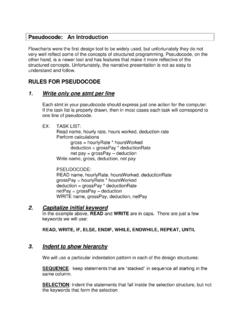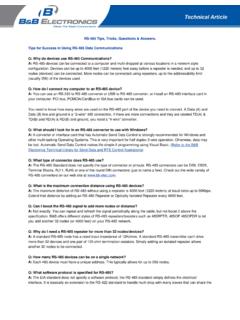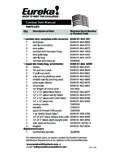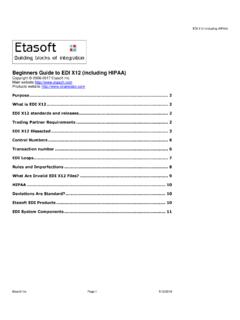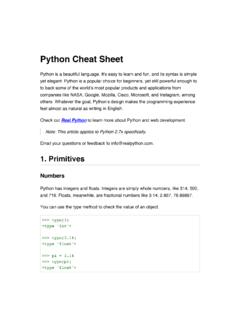Transcription of KENCO ENGINEERING COMPANY
1 Page 1 KENCO ENGINEERING COMPANY BOX 470426 TULSA, OK 74147-0426 PHONE: (918) 663-4406 FAX: (918) 663-4480 e-mail: SERIES KMD MAGNETOSTRICTIVE LIQUID LEVEL TRANSMITTER INSTALLATION / OPERATION INSTRUCTIONS TABLE OF CONTENTS 1. GENERAL DESCRIPTION .. 2 2. PRINCIPLE OF OPERATION .. 2 3. MODEL DESCRIPTION .. 2 4. INSTALLATION .. 3 5. OPERATIONAL 3 6. THREADED FLANGE MOUNTING .. 3 7. WELDED FLANGE 4 8. MAGNETIC GAUGE 5 9. WIRING .. 5 10. INSTALLATION (CONTROL) 6 11. PRODUCT DIMENSIONS .. 7 12. CONDUIT INSTALLATION .. 8 13. WIRING 8 14. 9 15. SETUP using ONBOARD KEYPAD AND 9 16. SETUP using HART 11 17. SETUP using PC SETUP SOFTWARE .. 12 18. SPECIFICATIONS .. 17 Page 2 GENERAL DESCRIPTION The KMD Series Magnetostrictive Liquid Level Transmitters are designed for very high accuracy measurement of virtually any liquid.
2 The KMD can be used as a stand-alone transmitter to measure level and/or interface in a vessel, or can be combined with the KENCO Series MLG Magnetic Gauge to provide a 4-20mA signal along with visual indication. PRINCIPLE OF OPERATION MODEL DESCRIPTION KMD - 1 - B - - - Output Housing Type Construction Material Process Connection (Type) Process Connection (Size) RTD (must select Output Code 2) Measurement Units Sensor Length Process Conn. (Size) RTD Measurement Units Sensor Length Description Code Description Code Description Code Inches ( ): A None 0 Millimeters M (20-300 inches) 1 B 3 from Bottom Tip of Sensor 1 Inches U Millimeters (xxxxx): 1 C Customer Specified Location 2 (508-7620 mm) 2 D 2 E 3 F 4 G 6 J None X Output Housing Type Description Code Description Code In-Tank Single Loop 1 Single Cavity B In-Tank Dual Loop 2 Dual Cavity C MLG Version (Display) 3 Single w/ Display D MLG Version (no Display) 4 Dual w/ Display E Construction Material Process Conn.
3 (Type) Description Code Description Code 316L SS 1 Swaged NPT 1 Hastelloy-C 3 Welded NPT 3 Teflon Sheathed 316L SS A 150# Flange 6 300# Flange 7 600# Flange 8 None X The Series KMD Transmitter will precisely sense the position of an external float by applying an interrogation (electrical) pulse to the waveguide. This pulse creates a magnetic field around the waveguide. The magnets inside the float also have a magnetic field. Where the two magnetic fields intersect, a rotational force is created (waveguide twist). This twist creates a sonic pulse that travels along the waveguide. The top of the sensing element houses the pick-up device that detects the sonic pulse and converts it into an electronic pulse. The electronic pulse is sent to the electronics module (puck), which calculates the time difference between the transmission of the interrogation pulse and the receipt of the sonic pulse.
4 This time differential is used to determine the exact position of the float, and is converted into a 4-20mA output signal. When used with a Magnetic Level Gauge (MLG), the float is contained in the MLG Chamber rather than on the Outer Pipe. However, the theory is the same. Waveguide Outer Pipe Float (moves with liquid level) Magnetic Field (from float magnets) Magnetic Field (from interrogation pulse) Waveguide Twist Float Magnets Page 3 INSTALLATION Unpack the switch carefully. Inspect all units for damage. Report any damage to carrier immediately. Check the contents against the packing slip and purchase order. KENCO s Magnetostrictive Liquid Level Transmitters are manufactured to the highest quality standards. These instruments use electronic components that can be damaged by static electricity. Make sure that you are properly grounded before starting installation. Insure that all electrical connections are properly made, and that there are no floating connections.
5 Operational Check Before installing the transmitter, a simple operational check should be performed, as follows: General Test 1. Open the electronics housing cover and connect power (see section on Wiring). 2. using a DC Volt Meter, measure the voltage at the Loop #1 connections. The voltage must be > and <36 Vdc. 3. If Loop #2 is being used, perform Step #2 on Loop #2. 4. If the voltage levels are not in range ( 36 Vdc), turn off the power. 5. Check for shorts/opens, power supply voltage (at supply), and excessive loop resistance (see resistance chart in section on Wiring). 6. If the voltage is too high, place a resistor in series with the transmitter to drop the excess voltage. Contact KENCO if you need assistance in calculating the correct resistance value. Loop #1 Test: 1. Connect a DC mA Meter in Loop #1 2. Lay the transmitter onto a flat surface. 3. Move the liquid level float along the operational range (zero to span) of the sensor.
6 The output current should change as the float moves. 4. If the loop current is less than 4mA or greater than 20mA, this could indicate a problem with the transmitter. Contact KENCO for assistance. Loop #2 Test: 1. Connect a DC mA Meter in Loop #2 2. If Loop #2 is being used to measure Liquid Interface, perform the Loop #1 test (steps 2 -4) with the interface float. 3. If Loop #2 is being used to measure Temperature, perform the following: a. Measure the loop current. b. Calculate the Temperature with the following formula: c. The transmitter s sensing RTD (Resistance Temperature Detector) is located approximately 3 from the bottom tip of the sensor (unless a different location is specified when ordered). Measure the temperature at this location to see if it is an approximation of the calculated value. If the output current is below 4mA or greater than 20mA there may be a problem with the sensing RTD.
7 Contact KENCO for assistance. Threaded Flange Mounting In applications with smaller vessels and tanks, the transmitter can be mounted directly to the vessel, by direct threaded connection or mounting flange by using a threaded NPT fitting (supplied on the sensor). This fitting can be adjustable (swaged) or welded to the sensor (determined by model configuration). If the float will not fit through the process connection, there must also be some means to mount the float from the inside of the vessel (see the Float Access Port on the following drawing). ()[]()mAmAmATITTT4420416+ =Where: T = Temperature T20mA = Temperature @ 20mA Setpoint (Factory Setting: 300 F) T4mA = Temperature @ 4mA Setpoint (Factory Setting: -30 F) I = Output Current (in mA) Page 4 For threaded process connections, screw sensor into the opening using a wrench on the NPT Fitting (bottom half for swaged fittings). Do not overtighten the upper nut on swaged fittings.
8 Use thread tape or suitable pipe compound on the process connection threads. If flanged, bolt the sensor flange to the mating flange with the proper gasket. Complete the following steps to mount the transmitter using the threaded flange method: 1. Remove the float retaining hardware, then remove the float. 2. Insert the tip of the sensor through the threaded vessel opening, or flange. 3. Before you completely insert the sensor tip to the bottom of the vessel, you must remount the float(s) and retaining hardware through an access port, or on the bottom side of the mounting flange. 4. The sensor tip can now be lowered to the vessel bottom and the connection can be made from the threaded NPT fitting to the vessel or mounting flange. In general, there should not be more than 12 inches of the Sensor Assembly extending above the vessel. Welded Flange Mounting The transmitter can also be mounted to a vessel flange with a flange welded to the sensor.
9 Be sure to use the appropriate gasket between the flange faces. NPT Fitting Tank Flange (provided by customer or ordered separately) Riser Float Access Port Retaining Hardware Sensor Assembly Tip of Sensor Welding Sleeve Diameter Retaining Hardware Riser Flange (welded to sensor) Page 5 Complete the following steps to mount the sensor using the welded flange method: 1. Remove the Retaining Hardware. Install the float(s) onto the sensor. Remount the retaining hardware. 2. Insert the sensor into the vessel. 3. Attach the Sensor Flange to the Vessel Flange. Magnetic Level Gauge (MLG) Mounting The transmitter can also be used in conjunction with a Magnetic Level Gauge (MLG) to provide a 4-20mA output, as well as visual indication of the level in the vessel. The MLG float contains a magnet which actuates the transmitter. The transmitter is mounted alongside the MLG, and held in place by hose clamps.
10 There is a minimum dead space of 3 at the bottom and 3 at the top. KENCO adds an additional 3 to the top (total of 6 ) for additional mounting flexibility. Complete the following steps to mount the sensor to the MLG: 1. Open the hose clamps and place them around the MLG Chamber. Close the hose clamps, but leave them loose. For transmitters less than 6ft. in length there are two hose clamps. For longer gauges, there is an additional hose clamp for every 3ft. of length. 2. Mount the sensor alongside the MLG chamber, 90 from the visual indicator. The sensor must be between the hose clamps and the MLG Chamber. 3. Tighten the bottom hose clamp directly above the bottom hose clamp holding the visual assembly in place. Tighten the top hose clamp directly below the top hose clamp holding the visual assembly in place. Starting at the bottom, tighten any additional hose clamps 36 apart. Wiring It is recommended that conduit be installed onto the NPT connection on the electronics housing.



